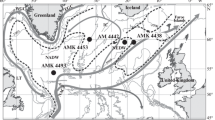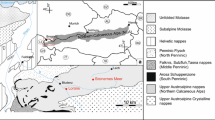Abstract
Based on benthic foraminifera from three sediment cores, the deep-water circulation near the Hunter Channel (Southwest Atlantic) in the Late Pleistocene and Holocene has been reconstructed (marine isotope stages (MIS) 4–1). Today, the North Atlantic Deep Water (NADW) moves through the Hunter Channel from north to south. At MIS 2 and 4, lower NADW flowed in the same direction. At MIS 3, NADW, Antarctic Bottom Water (AABW), and Lower Circumpolar Deep Water (LCDW) periodically appeared in the Hunter Channel. On the approach to the Hunter Channel from the Argentine Basin, there are no AABW signatures in the Late Pleistocene or Holocene. In the Holocene, carbonates dissolved in the deeper eastern part of the Hunter channel. During glaciations, dissolution processes intensified and also reached the western part of the channel. Dissolution proceeded and continues to proceed not because of AABW but NADW, which becomes aggressive here toward calcium carbonate.




Similar content being viewed by others
REFERENCES
M. S. Barash, Quaternary Paleooceanology of the Atlantic Ocean (Nauka, Moscow, 1988) [in Russian].
M. S. Barash, N. S. Blyum, and N. S. Os’kina, “Quaternary paleotemperatures and sedimentation in the area of Rio Grande Rise,” Dokl. Akad. Nauk SSSR 291, 928–931 (1986).
O. B. Dmitrenko, N. P. Lukashina, and N. S. Os’kina, “Upper quaternary biostratigraphy and formation environments of the southwestern Atlantic Core ACB‑17-1447 inferred from micropaleontological data,” Oceanology (Engl. Transl.) 52, 249–260 (2012).
A. P. Lisitsyn, “Zonality of environment and sedimentation in the oceans,” in Climatic Zonality and Sedimentation (Nauka, Moscow, 1981), pp. 5–45.
N. P. Lukashina, “Distribution of benthic foraminiferans in the Northern Atlantic,” Okeanologiya (Moscow) 28, 632–638 (1988).
N. P. Lukashina, “Modern dissolution of carbonate substances in the tropical Atlantic according to the foraminiferal analysis,” Okeanologiya (Moscow) 32, 550–556 (1991).
N. P. Lukashina, “Late Quaternary abyssal circulation of waters in Canary Depression according to analysis of benthic foraminiferans,” Okeanologiya (Moscow) 32, 326–336 (1992).
N. P. Lukashina, Paleooceanology of the Northern Atlantic in Late Secondary and Cainozoe Periods, and Appearance of Present Global Thermohaline Conveyor Based on the Studies of Foraminifers (Nauchnyi Mir, Moscow, 2008) [in Russian].
E. G. Morozov, T. A. Demidova, S. S. Lappo, et al., “Antarctic bottom water flow through the Vema Channel,” Dokl. Earth Sci. 390, 593–596 (2003).
V. N. Stepanov, Oceanosphere (Mysl’, Moscow, 1983) [in Russian].
A. V. Altenbach, U. Pflauman, R. Schiebel, et al., “Scaling percentages and distributional patterns of benthic foraminifera with flux rates of organic carbon,” J. Foraminiferal Res. 29 (3), 173–185 (1999).
M. S. Barash, N. S. Oskina, and N. S. Blyum, “Quaternary biostratigraphy and surface paleotemperatures by means of planktonic foraminifers sites 515 and 518 DSDP Leg 72,” Initial Rep. Deep Sea Drill. Proj. 72, 849–869 (1983).
W. H. Berger, “Selective solution and paleoclimatic interpretation,” Deep-Sea Res. 15, 31–43 (1968).
W. H. Berger, “Paleoceanography: the deep-sea record,” in The Sea, Vol. 7: The Oceanic Lithosphere, Ed. by C. Emiliani (Harvard University Press, Cambridge, 1981), pp. 1437–1519.
W. A. Berggren, N. Hamilton, D. A. Johnson, et al., “Magnetobiostratigraphy of Deep-Sea Drilling Project Leg 72, sites 515–518, Rio Grande Rise (South Atlantic),” Initial Rep. Deep Sea Drill. Proj. 72, 939–948 (1983).
M. E. Bylinskaya, “Range and stratigraphic significance of the Globorotalia crassaformis plexus,” J. Iberian Geol. 31, 51–63 (2004).
W. Christopher and C. W. Smart, “Abyssal NE Atlantic benthic foraminifera during the last 15 kyr: relation to variations in seasonality of productivity,” Mar. Micropaleontol. 69, 193–211 (2008).
B. H. Corliss and A. E. Rathburn, “Pore characteristics of deep-sea benthic foraminifera and linkage to oxygen levels,” in Proceedings of the 33rd International Geological Congress (Oslo, 2008).
S. De and A. K. Gupta, “Deep-sea faunal provinces and their inferred environments in the Indian Ocean based on distribution of recent benthic foraminifera,” Palaeogeogr., Palaeoclimatol., Palaeoecol. 291, 429–442 (2010).
M. Fariduddin and P. Loubere, “The surface ocean productivity response of deeper water benthic foraminifera in the Atlantic Ocean,” Mar. Micropaleontol. 32, 289–310 (1997).
C. Fontanier, F. J. Jorissen, G. Chaillou, et al., “Seasonal and interannual variability of benthic foraminiferal faunas at 550 m depth in the Bay of Biscay,” Deep Sea Res., Part I 50 (4), 457–494 (2003).
S. L. Garzoli and R. Matano, “The South Atlantic and the Atlantic meridional overturning circulation,” Deep Sea Res., Part II 58, 1837–1847 (2011).
G. Gudmundsson, “Distributional limits of Pyrgo species at the biogeographic boundaries of the Arctic and the North-Atlantic Boreal regions,” J. Foraminiferal Res. 28 (3), 240–256 (1998).
N. Hogg, P. Biscaye, W. Gardner, and W. J. Schmitz, “On the transport and modification of Antarctic Bottom Water in the Vema Channel,” J. Mar. Res. 40, 231–263 (1982).
D. F. Hodell and J. P. Kennett, “Climatically induced changes in vertical water masses structure of the Vema Channel during the Pliocene: evidence from Deep-Sea Drilling Project holes 516 A, 517 and 518,” Initial Rep. Deep Sea Drill. Proj. 72, 907–919 (1983).
D. A. Johnson, “The Vema Channel: physiography, structure, and sediment—Current interactions,” Mar. Geol. 58 (1–2), 1–34 (1984).
D. A. Johnson, V. Ledbetter, and L.Burckle, “Vema Channel paleooceanography dissolution cycles and episodic bottom water flow,” Mar. Geol. 23, 1–33 (1977).
D. Johnson, S. E. McDowell, L. G. Sulhvan, and P. E. Biscaye, “Abyssal hydrography, nephelometry, currents, and benthic boundary layer structure in the Vema Channel,” J. Geophys. Res. 8 (1), 5771–5786 (1976).
G. A. Jones, D. A. Johnson, and W. B. Curry, “High-resolution stratigraphy in late Pleistocene/Holocene sediments of the Vema Channel,” Mar. Geol. 58 (1–2), 59–87 (1984).
M. T. Ledbetter, “Bottom-current speed in the Vema Channel recorded by particle size of sediment fine-fraction,” Mar. Geol. 58 (1–2), 137–149 (1984).
M. T. Ledbetter, “A Late Pleistocene time-series of bottom-current speed in the Vema Channel,” Palaeogeogr., Palaeoclimatol., Palaeoecol. 53 (1), 97–105 (1986).
P. Linke and Lutze, G.F. “Microhabitat preferences of benthic foraminifera a static concept or a dynamic adaptation to optimize food acquisition?” Mar. Micropaleontol. 20 (3–4), 215–234 (1993).
G. P. Lohman, “Abyssal benthonic foraminifera as hydrographic indicators in the Western South Atlantic Ocean,” J. Foraminiferal Res. 8 (1), 6–34 (1978).
G. F. Lutze and W. T. Coulbourn, “Recent benthic foraminifera from the continental margin of northwest Africa: Community structure and distribution,” Mar. Micropaleontol. 8 (5), 361–401 (1984).
A. Mackensen, D. K. Fiitterer, H. Grobe, and G. Schmiedi, “Benthic foraminiferal assemblages from the eastern South Atlantic Polar Front region between 35° and 57°S: distribution, ecology and fossilization potential,” Mar. Micropaleontol. 22, 33–69 (1993).
A. Mackensen, G. Schmiedl, J. Harloff, and M. Giese, “Deep-sea foraminifera in the South Atlantic Ocean: ecology and assemblage generation,” Micropaleontology 41 (4), 342–358 (1995).
G. A. Mead, “Recent benthic foraminifera in the Polar Front region of the southwest Atlantic,” Micropaleontology 31 (3), 221–248 (1985).
C. Morigi, F. J. Jorissen, A. Gervais, et al., “Benthic foraminiferal faunas in surface sediments off NW Africa: Relationship with organic flux to the ocean floor,” J. Foraminiferal Res. 31, 350–368 (2001).
E. G. Morozov and R. Yu. Tarakanov, “The flow of Antarctic bottom water from the Vema Channel to the Brazil Basin,” Dokl. Earth Sci. 456, 598–601 (2014).
D. S. Murgese and P. De Deckker, “The distribution of deep-sea benthic foraminifera in core tops from the eastern Indian Ocean,” Mar. Micropaleontol. 56, 25–49 (2005).
L. C. Peterson and G. P. Lohman, “Major change in Atlantic deep and bottom waters 700 000 years ago: benthonic foraminiferal evidence from the South Atlantic,” Quat. Res. 17, 26–38 (1982).
R. G. Peterson and L. Stramma, “Upper-level circulation in the South Atlantic Ocean,” Prog. Oceanogr. 26, 1–73 (1991).
D. Schnitker, “Quaternary deep-sea benthic foraminifera and bottom water masses,” Annu. Rev. Earth Planet. Sci. 8, 343–379 (1980).
C. W. Smart and A. J. Gooday, “Recent benthic foraminifera in the abyssal northeast Atlantic Ocean: relation to phytodetrital inputs,” J. Foraminiferal Res. 27, 85–92 (1997).
K. Speer, W. Zenk, G. Siedler, et al., “First resolution of flow through the Hunter Channel in the South Atlantic,” Earth Planet. Sci. Lett. 113, 287–292 (1992).
K. Speer and W. Zenk, “The flow of Antarctic bottom water into the Brazil Basin,” J. Phys. Oceanogr. 23, 2667–2682 (1993).
S. S. Streeter, “Bottom water and benthonic foraminifera in the North Atlantic—Glacial-interglacial contrasts,” Quat. Res. 3, 131–141 (1973).
X. Sun, B. H. Corliss, C. W. Brown, and W. J. Showers, “The effect of primary productivity and seasonality on the distribution of deep-sea benthic foraminifera in the North Atlantic,” Deep Sea Res., Part I 53, 28–47 (2006).
E. Tappa and R. Thunell, “Late Pleistocene glacial/interglacial changes in planktonic foraminiferal biofacies and carbonate dissolution patterns in the Vema Channel,” Mar. Geol. 58, 101–122 (1984).
E. Thomas, L. Booth, M. Maslin, and N. J. Shackleton, “Northeastern Atlantic benthic foraminifera during the last 45 000 years: changes in productivity seen from the bottom up,” Paleoceanography 10, 545–562 (1995).
W. Zenk and E. Morozov, “Decadal warming of the coldest Antarctic bottom water flow through the Vema Channel,” Geophys. Res. Lett. 34, 1–5 (2007).
P. K. Weyl, “The role of oceans in climatic changes: a theory of the Ice Ages,” Meteorol. Monogr. 8 (30), 37–62 (1968).
Author information
Authors and Affiliations
Corresponding author
Additional information
Translated by A. Carpenter
Rights and permissions
About this article
Cite this article
Lukashina, N.P. Deep-Water Circulation in the Hunter Channel (Southwest Atlantic) in the Late Pleistocene and Holocene Based on Benthic Foraminifera. Oceanology 59, 123–132 (2019). https://doi.org/10.1134/S0001437019010132
Received:
Accepted:
Published:
Issue Date:
DOI: https://doi.org/10.1134/S0001437019010132




